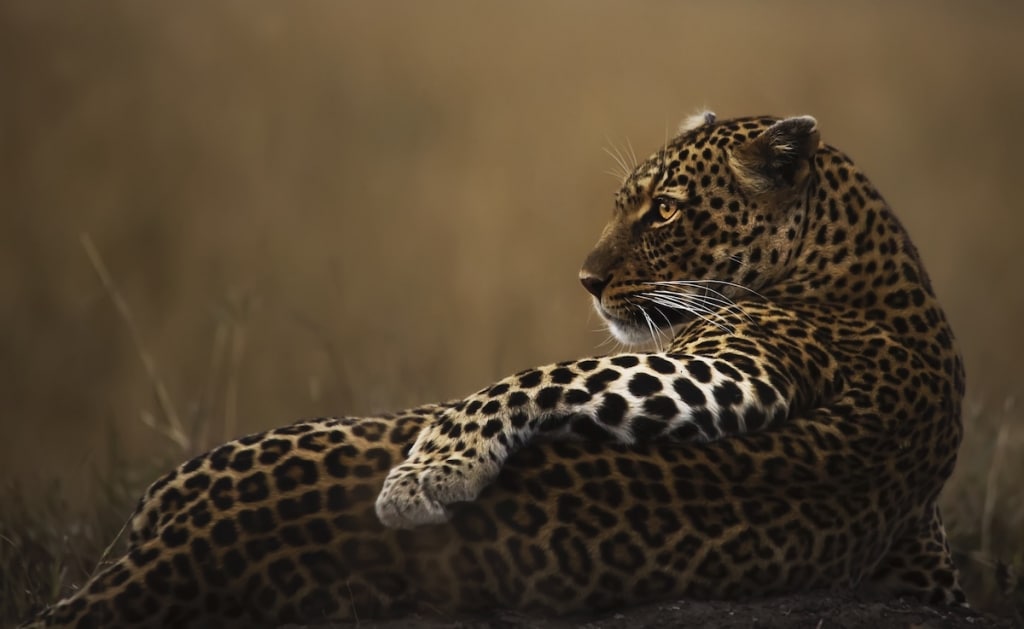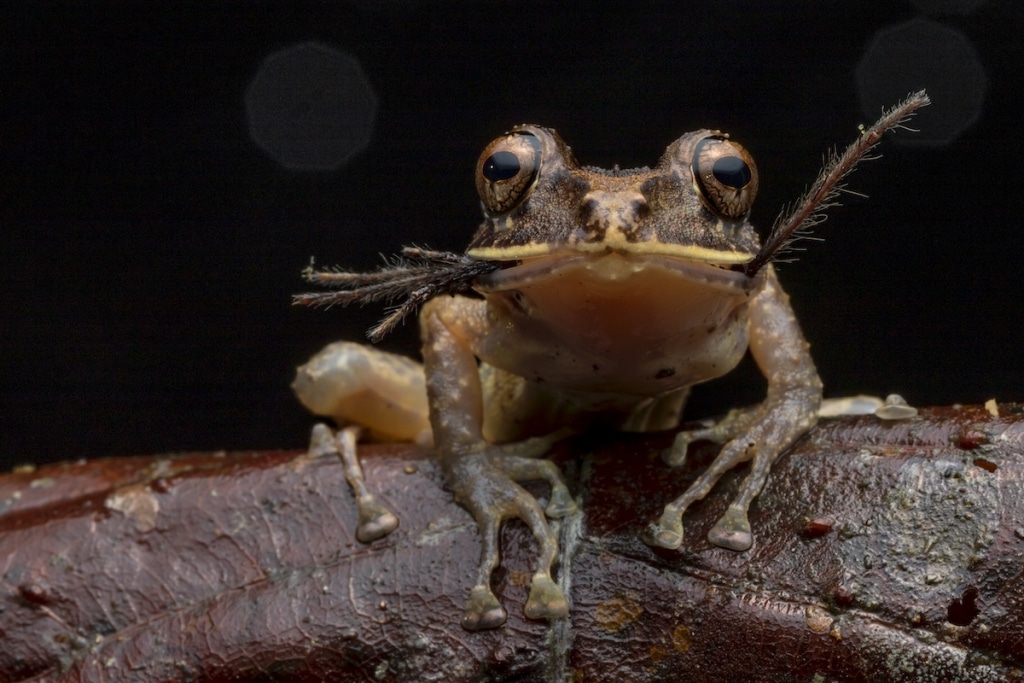
“What a poser” by Clement Mwangi, Kenya.
In Kenya’s Maasai Mara National Reserve, Clement spent time observing this beautiful leopard as she soaked up the last warm rays of the setting sun. Clement is mindful to remember to take pleasure in life’s simple moments – being all too aware that sometimes, as a wildlife photographer, you can miss the exceptional while looking for the unusual.
The prestigious Wildlife Photographer of the Year contest may have handed out its awards but now the public will have their say thanks to the LUMIX People's Choice Award. Wildlife photography lovers can now go online and vote for their favorite of 25 images selected by the National History Museum in London. In a pool of 48,000 images to choose from, these photographs rose to the top in their ability to communicate a message about the natural world.
The shortlisted images are currently on display at the Wildlife Photographer of the Year exhibition in London until voting ends in early February. At that point, only the LUMIX People's Choice winner will remain in the acclaimed exhibition until it ends its run in May 2020. From photographs that explore the connection between humans and animals to portraits that focus on their stunning beauty, the shortlist is a lovely cross-section of wildlife imagery. The strength of the work makes it all the more difficult to decide who should come out on top.
“The LUMIX People’s Choice images capture the essence of the competition; they all ignite a reaction about the natural world and make you see it differently,” shares Tim Littlewood, Executive Director of Science at the Natural History Museum. “Showcasing breath-taking beauty, compassion, and cruelty, it is impossible not to be moved by them–I think everyone who votes has a tough decision to make!”
Want to share your opinion? Vote for the LUMIX People's Choice Award online; you have until February 4, 2020 at 2 pm GMT to make your selection.
Check out some of the shortlisted entries for the LUMIX People's Choice Award.

“Beak to beak” by Claudio Contreras Koob, Mexico.
Ría Lagartos Biosphere Reserve in the state of Yucatán is home to Mexico’s largest flock of Caribbean flamingos. This chick is less than five days old – it will stay in its nest less than a week before it joins a crèche of other youngsters who wander around the colony searching for food.

“Inquisitive” by Audan Rikardsen, Norway.
From a hide on the coast of northern Norway, it took Audun three years of planning to capture this majestic bird of prey in its coastal environment. After some time, the golden eagle became curious of the camera and seemed to like being in the spotlight.

“The surrogate mother” by Martin Buzora, Canada.
Elias Mugambi is a ranger at Lewa Wildlife Conservancy in northern Kenya. He often spends weeks away from his family caring for orphaned black rhinos like Kitui here. The young rhinos are in the sanctuary as a result of poaching or because their mothers are blind and cannot care for them safely in the wild.

“Training session” by Stefan Christmann, Germany.
When Stefan came across this penguin couple in Atka Bay, Antarctica, seemingly with an egg, he was surprised as it was too early in the season for egg-laying. Upon closer inspection he discovered the egg was a snowball! Perhaps the diligent couple were practicing egg transfer in preparation for when their real egg arrived. This is possibly the first time it has ever been witnessed and documented.
As part of the Wildlife Photographer of the Year contest, the winner will go on display at the Natural History Museum, London.

“Losing the fight” by Aaron Gekoski, UK.
Orangutans have been used in degrading performances at Safari World, Bangkok – and many other locations – for decades. The shows were temporarily stopped in 2004 due to international pressure, but today the shows continue – twice a day, every day – with hundreds of people paying to watch the orangutans box, dance, play the drums and more.

“Station squabble” by Sam Rowley, UK.
Sam discovered the best way to photograph the mice inhabiting London’s Underground was to lie on the platform and wait. He only saw them fight over scraps of food dropped by passengers a few times, possibly because it is so abundant. This fight lasted a split second, before one grabbed a crumb and they went their separate ways.

“The unwelcome visitor” by Salvador Colvée Nebot, Spain.
Over several months, Salvador watched different species of bird use the dead flower spike of the agave in Valencia, Spain as a perch before descending to a small pond to drink. A pair of common kestrels were frequent visitors though each time they came magpies would hassle them.

“Captive” by Marcus Westberg, Sweden.
A giant panda sits in its cage in a breeding centre in Shaanxi, China. With a growing wild population and no realistic plan of how to breed and raise pandas for rerelease into the wild rather than a life in captivity – not to mention lack of habitat being the largest barrier to the continued spread of the wild population – it is unclear how such centres will benefit the species.
Go online to see the full list and vote for your favorite photo until February 4, 2020.

“Dressed for dawn” by Csaba Tökölyi, Hungary.
Csaba had been in a hide all night photographing nocturnal species and their activities, but as the golden light of dawn reflected on the surface of the water, an egret in wonderful breeding plumage stopped close by. The elongated scapular feathers covered the bird as if it was wearing a gown.

“A pulsing sea” by David Doubilet, USA.
A school of red tooth triggerfish form a cloud of silhouettes above a river of convict blennies flowing over the coral in Verde Island Passage, Philippines. The Passage, a strait that separates the islands of Luzon and Mindoro, is one of the most productive marine ecosystems in the world.

“Trustful” by Ingo Ardnt, Germany.
For over two years, Ingo has followed the pumas of Torres del Paine National Park, in Patagonia, Chile. This female was so used to his presence that one day she fell asleep nearby. On awakening, she glanced at him in a familiar way, and he was able to capture this portrait of a completely relaxed puma.

“Bon appétit” by Lucas Bustamente, Ecuador.
Night hikes through the Ecuadorian jungle are one of Lucas’ favourite activities. With a keen interest in herpetology, he was overjoyed to spot this labiated rainfrog which are abundant in the region. It had just caught a baby tarantula and its comical expression said ‘caught in the act!’

“Family get-together” by Michael Schober, Austria.
Marmots have become accustomed to the presence of humans in Hohe Tauern National Park, Austria and allow people to observe and photograph them at close range. This behaviour is beneficial for the marmots, as human company deters predators such as golden eagles.

“Teamwork” by Jake Davis, USA.
Jake was on a boat off the coast of Great Bear Rainforest, British Columbia, Canada where he watched humpback whales bubble-et feeding. Here the leader whale dives to locate the fish, once the fish are located, the rest of the pod swim in decreasing circles while blowing bubbles which create a net, trapping the fish.

“Matching outfits” by Michel Zoghzoghi, Lebanon.
Michel was in the Pantanal, Brazil photographing jaguars. One afternoon, as he was on the Três Irmãos River, a mother and her cub crossed right in front of his boat. He watched mesmerized as they left the water holding an anaconda with a very similar pattern to their own.
Wildlife Photographer of the Year: Website | Facebook | Instagram
My Modern Met granted permission to feature photos by the Natural History Museum – Wildlife Photographer of the Year.
Related Articles:
15 Powerful Finalists from the 2019 Wildlife Photographer of the Year Contest
Touching Moment Between Two Lions Wins Wildlife Photographer of the Year People’s Choice Award
Interview: This 14-Year-Old Wildlife Photographer Is Impressing the Pros and Winning Awards
Adorably Hilarious Winners of the 2019 Comedy Wildlife Photography Awards






















































































